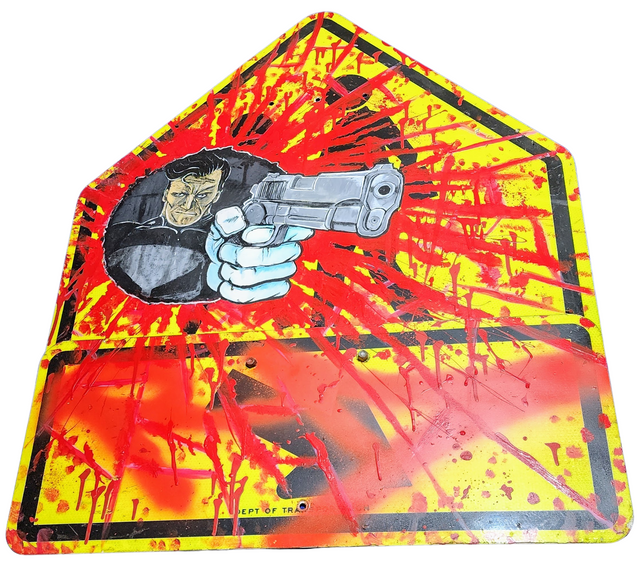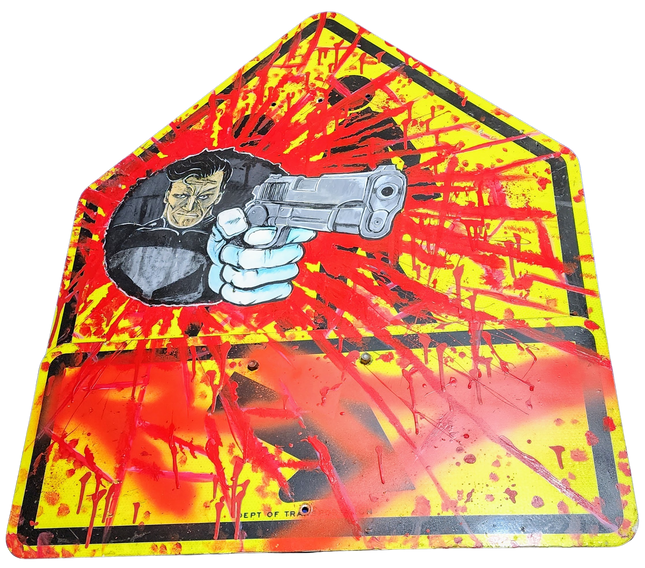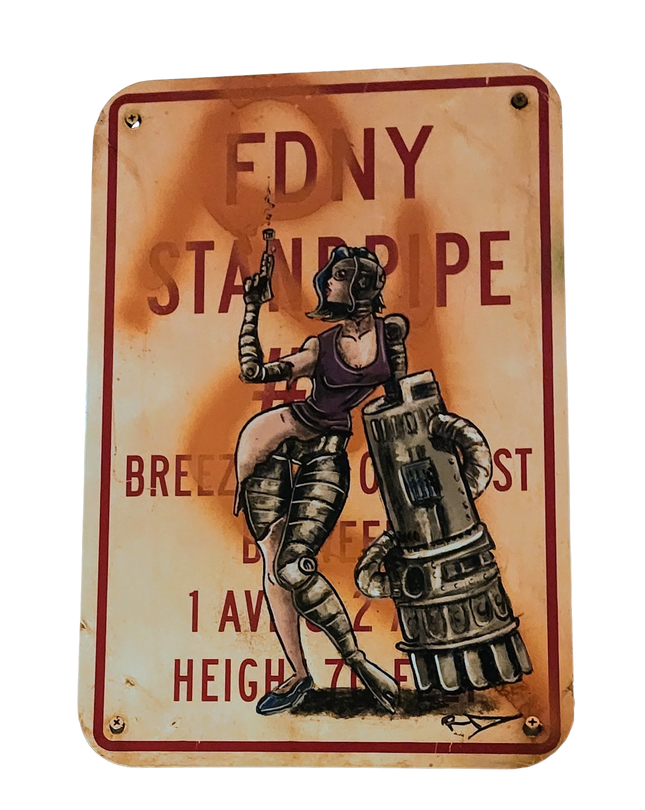
Street Signs

RD-357 Real Deal Punisher Crossing Original Street Sign Painting by RD-357 Real Deal
Punisher Crossing Original Street Sign Painting by RD-357 Real Deal One of a Kind Artwork on Real Metal Crosswalk Street Sign by Graffiti Art Pop Artist. 2012 Signed Mixed Media Acrylic & Spray Paint on Real Reclaimed NYC New York City Crossing Cross Walk Street Sign Painting Original Artwork Size 30x37.5 RD-357: Pioneering Street Pop Art on Urban Canvases RD-357, an artist known for his distinctive contribution to street pop art and graffiti artwork, has manifested his creativity through a unique, striking, and thought-provoking medium. His original piece titled "Punisher Crossing Original Street Sign Painting" encapsulates street art's raw essence while ingeniously infusing pop culture iconography elements. This work is a stellar example of RD-357's inventive use of everyday objects as canvases, transforming a mundane metal crosswalk street sign into a vibrant artwork that commands attention and sparks dialogue. The "Punisher Crossing" is a unique artwork that exudes the rebellious spirit and subversive edge often associated with street pop art. Created in 2012, this mixed media piece employs acrylic and spray paint on a real crossing sign measuring 30x37.5 inches. RD-357's choice to use an actual street sign as the foundation for his artwork not only repurposes the object but also embeds the art piece within the fabric of urban life it seeks to comment on. The sign, once a directive for pedestrians, now carries a powerful visual message, made all the more potent by its placement on an object of regulation and order. The Artistic Language of RD-357's Street Sign Paintings In "Punisher Crossing," RD-357 demonstrates a masterful control over color and composition. The background of the sign is ablaze with a vivid, almost violent splatter of yellow and red spray paint, reminiscent of the chaos and energy of city streets. Against this explosive backdrop, the figure of the Punisher is rendered with precision in acrylic, his stark, menacing presence immediately drawing the eye. The character's hand, outstretched and holding a gun, breaks the boundaries of the sign's frame, suggesting a defiance of constraints and a breaking free from imposed limits. RD-357's work is deeply embedded in the language of street pop art, a genre that combines the gritty, underground aesthetic of street art with the bright, graphic quality of pop art. His paintings, especially this piece, are a dialogue between the artist and the urban landscape, between the fictional characters of pop culture and the reality of the viewer's environment. By bringing the Punisher - a symbol of vigilante justice and anti-heroism - into the context of a crosswalk sign, RD-357 creates a juxtaposition that is at once startling and intriguing. The artwork becomes a statement on control and chaos, power and powerlessness, and the fine line between societal order and individual action. RD-357's Impact on Contemporary Street Art RD-357's contributions to the street art scene have been significant, and his influence can be seen in the way street pop art has evolved over the years. His artworks, particularly those on street signs, are more than mere paintings; they are interventions into the urban environment, which challenge the viewer to reconsider the role and potential of public space. The "Punisher Crossing" sign is emblematic of this approach, seamlessly integrating art into the city's daily liandlso elevating the discourse around street art. By signing his work, the artist claims ownership of a public domain piece, an act that is a form of artistic rebellion. The signature on "Punisher Crossing" is not merely a mark of authenticity; it is a declaration of presence, a proof of the artist's interaction with the world around him. Through works like this, RD-357 has etched his name into the annals of street pop art history, securing his place as a maverick who has expanded the possibilities of graffiti artwork. The "Punisher Crossing Original Street Sign Painting" by RD-357 stands as a testament to the power of street pop art to communicate, provoke, and inspire. By transforming a simple street sign into a complex and compelling work of art, RD-357 challenges perceptions, invites reflection, and continues influencing the ever-evolving narrative of street and graffiti art.
$3,000.00

RD-357 Real Deal Techno Standpipe Original Street Sign Painting by RD-357 Real Deal
Techno Standpipe Original Street Sign Painting by RD-357 Real Deal Spray Paint Mixed Media is one of the kinds of artwork on New York City FDNY Standpipe Notice Sign Pop Graffiti Street Artwork. 2014 Signed Spray Painting Original Artwork on Real Reclaimed NYC Fire Fighter Metal Urban City Street Sign Size 13x18 Futuristic Sci-Fi Cyborg Robot Woman with Guns & Future Weapon Arm Replacement—RD Tag in Rust Red. RD-357's Techno Standpipe: A Metaphor of Futurism in Street Art The original Techno Standpipe street sign painting by RD-357, also known as Real Deal, is a compelling piece of street pop art that seamlessly blends technology and urban grit. Created in 2014, this work of art reimagines a New York City Fire Department standpipe notice sign as a backdrop for a dystopian narrative. The piece, signed by RD-357, features a futuristic sci-fi cyborg woman armed with advanced weaponry, conveying powerful themes of transformation and the intersection of humanity and technology. Symbolism and Significance in RD-357's Artwork In 'Techno Standpipe,' the cyborg woman symbolizes the evolving relationship between humans and machines. Her robotic arm replacement, depicted with meticulous detail, suggests enhancement and perhaps the loss of human elements, a theme that resonates deeply in an era where technology increasingly interfaces with every aspect of life. The choice of a standpipe sign, an emblem of safety and regulation, contrasts with the unrestrained and anarchic spirit of the cyborg, creating a visual paradox that challenges the viewer to consider the implications of technological advancement. The RD tag in rust red serves as the artist's signature and integration into the piece's aesthetic, echoing the rust and decay that often accompany urban infrastructure. This artwork, measuring 13x18 inches, uses spray paint to bring to life the textures and tones of metal and flesh, bridging the gap between the industrial and the organic. RD-357's Technique and Artistic Vision RD-357's execution of 'Techno Standpipe' demonstrates a masterful use of mixed media, combining the stark, flat surface of a metal sign with the depth and dynamism of spray paint. The artist employs shading, contouring, and color contrasts to give the cyborg figure a three-dimensional appearance, projecting her out of the sign's flatness and into the viewer's space. The shadows and highlights create a sense of movement, suggesting action and energy, symbolic of street pop art's dynamic nature. The artwork's gritty realism, underscored by the wear and tear on the sign itself, reflects the urban environment's influence on RD-357. Using a real street sign repurposes the found object and contextualizes the art within the living, breathing cityscape. This piece thus becomes a conversation between the artist, the medium, and the ever-changing urban landscape. The Cultural Resonance of 'Techno Standpipe' As a piece of street pop art and graffiti, 'Techno Standpipe' carries within it the pulse of contemporary culture, where concerns about the encroachment of technology into the human sphere are ever-present. RD-357 captures this zeitgeist, presenting a future vision that is both a warning and a wonder. The artwork invites introspection on the viewer's part, urging them to contemplate the direction in which society is headed. RD-357, whose real name and country of origin remain anonymous, maintains the tradition of street artists who operate under pseudonyms, preserving the mystery and rawness central to the genre. The 'Techno Standpipe' is a bold statement within RD-357's oeuvre, a one-of-a-kind piece that embodies the transformative and provocative power of street pop art and graffiti artwork. It is a visual manifesto of the times, a metallic cry from the city's heart that resonates with modern existence's complexities.
$600.00



